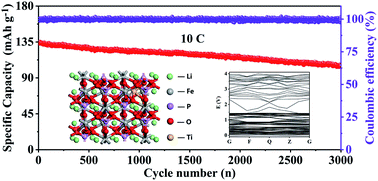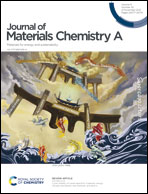A high-rate capability LiFePO4/C cathode achieved by the modulation of the band structures†
Abstract
As a highly safe and low-cost cathode material for lithium-ion batteries, LiFePO4 predominately suffers from undesirable rate performance, arising from its inferior conductivity, during practical applications. Herein, LiFePO4 modified with a modulated band structure, as theoretically predicted, was successfully designed to overcome this deficiency. Notably, replacing the Li sites with Ti4+ led to tuned band structures, giving rise to an effective reduction of the forbidden bandwidth and the activated delocalization of the d-orbital electrons, as clearly observed using density functional theory calculations. Importantly, it also induces the shrinkage of the particle size, reducing the transport distance for Li+ inside the particles, as verified using Rietveld refinement of the X-ray diffraction spectra. As expected, electronic transfer and Li+ transport are synchronously accelerated thanks to the appropriate doping of Ti4+ in the olivine lattice, confirmed based on the measurement of the conductivity and calculations of the Li+ diffusion coefficient. Hence, the as-optimized cathode (0.5% Ti4+-LFP/C) exhibits an excellent rate capacity (135 mA h g−1 at 10C within 2.5–4.2 V) with superior long-term cycling stability (78% capacity retention after 3000 cycles). Based on these results, the dramatic improvement in the rate performance achieved via modulating the band structures and the ionic diffusion may provide novel opportunities for the development of olivine cathode materials.



 Please wait while we load your content...
Please wait while we load your content...